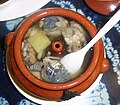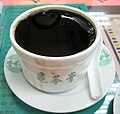Steaming
 From Wikipedia - Reading time: 11 min
From Wikipedia - Reading time: 11 min

Steaming is a method of cooking using steam. This is often done with a food steamer, a kitchen appliance made specifically to cook food with steam, but food can also be steamed in a wok. In the American Southwest, steam pits used for cooking have been found dating back about 5,000 years. Steaming is considered a healthy cooking technique that can be used for many kinds of foods.
Compared to full immersion in boiling water, steaming can be faster and more energy-efficient because it requires less water and takes advantage of the excellent thermodynamic heat transfer properties of steam.
History
[edit]
Some of the world's earliest examples of steam cooking were found in China's Yellow River Valley; early steam cookers made of stoneware have been found dating back as far as 5,000 BCE.[1] And also in Gunma Prefecture, Japan, created during the Stone Age.[2][3] Some of the earliest examples of steam cooking have been found in Italy and Sardinia, created during the Bronze Age,[4] and in Cochise County, Arizona, where steam pits were used for cooking about 10,000 years ago.[5] From the eighth century CE,[citation needed] thin cypress strips were used to make steamers; today, their slatted bases are constructed from bamboo. The classic steamer has a chimney in the center, which distributes the steam among the tiers.[citation needed]
While steaming has not caught up in the west for assorted dishes, the technique has been heavily popularized worldwide by Chinese and East Asian cuisine.[6] The two main classic steamers feature the ancient bamboo steamer as well as the modern metal (aluminium or stainless steel) steamer, with the difference being that the bamboo lid takes longer to heat up but absorbs excess moisture and allows heat to condense again over the delicate food.[7] Other developments were the creation of microwaveable silicone steamers and plastic-hybrid steamers.[7]
Method
[edit]
Steaming works by boiling water continuously, causing it to vaporize into steam; the steam then carries heat to the nearby food, thus cooking the food. The food is kept separate from the boiling water but has direct contact with the steam, resulting in a moist texture to the food. This differs from double boiling, in which food is not directly exposed to steam, or pressure cooking, which uses a sealed vessel but is capable of pressure steaming or submerging.[citation needed]
Such cooking is most often done by placing the food in a food steamer, typically a circular container made of metal, wood, or bamboo. The steamer usually has a lid that is placed on top of the container during cooking to allow the steam to cook through the food. When a steamer is unavailable, food can be steamed inside a wok, supported over boiling water in the bottom of the wok by a metal frame. Some modern home microwave ovens include a structure to cook food with steam vapor produced in a separate water container, providing a similar result to being cooked on a stove. There are also specialized steam ovens available.[citation needed]
-
A simple hearth with a metal pan holding two wooden steaming vessels and a wooden lid used in Japan
-
A makeshift steaming vessel with lid removed; a frozen dish is placed on a metal frame in a single handled wok with water.
Steamed foods
[edit]
In Japan, glutinous rice is steamed to prepare mochi rice cakes. Traditional Japanese sweets or wagashi making involves steaming rice or wheat dough for making mochigashi and manju.[citation needed]

In Western cooking, steaming is most often used to cook vegetables—it is rarely used to cook meats. However, steamed clams are prepared by steaming. With Chinese cuisine, vegetables are usually stir fried or blanched and seldom steamed. Seafood and meat dishes are steamed. For example: Steamed whole fish, steamed crab, steamed pork spare ribs, steamed ground pork or beef, steamed chicken and steamed goose.[citation needed]
Rice can be steamed too, although in Chinese cooking this is simply referred to as "cooking" rather than "steaming". In Thailand steaming is the definition of minimalist cooking.[8] Wheat foods are steamed as well. Examples include buns and Chinese steamed cakes. Similarly, in Mexican and Central American cuisine, tamales are made by steaming a dough made from nixtamalized maize (called masa) in wrappers made from corn husks or banana leaves; the dough can be stuffed or left plain.[citation needed]
Steamed meat dishes (except fish and some dim sum) are less common in Chinese restaurants than in traditional home cooking,[9] because meats usually require longer cooking times to steam than to stir fry. Commercially sold frozen foods (such as dim sum) formerly had instructions to reheat by steaming, until the rise in popularity of home microwave ovens, which have considerably shorter cooking times.[citation needed]
Chinese dishes
[edit]

Staple foods
- Siu mai, meat dumplings
- Har gao, shrimp dumplings
- Baozi, filled buns
- Lion's head meatballs
- Steamed meatballs
- Pearl meatballs, pork meatballs covered in sticky rice
Rice
- Steamed rice with crab, Fujian cuisine called 蠘飯 (蟳飯)
- Fenzhengrou (粉蒸肉): Steamed pork with rice flour
Seafood
- Fish: Chinese perch, grouper, Japanese black porgy
- Crab: Chinese mitten crab, Shanghai cuisine for the autumn
Soup
- Weitang: Steamed pork rib soup, Jiangxi cuisine
- Buddha Jumps Over the Wall: Fujian cuisine
- Winter Melon Soup: Using a hollowed out and sculpted gourd as a vessel
- Qi Guoji Steamed Chicken Soup: Chicken soup cook in a double steamer, Yunnan cuisine
Sweets
- Double skin milk, said to be made in the 1850s in Daliang in Foshan, Guangdong
- Guilinggao: also known as Turtle Jelly, a jelly-like Chinese medicine, also sold as a dessert
Others
- Chinese steamed eggs similar to custard with local variety of ingredients and vessels.
-
Variety of dim sum
-
Buddha Jumps Over the Wall, or Buddha's Temptation
-
A small bowl of winter melon soup
-
Steamed silkie soup
-
Turtle jelly
Japanese dishes
[edit]- Glutinous rice. Instead of boiling, glutinous rice is steamed to eat. Okowa (おこわ (強飯)) as it is called, receipts with ingredients and vessel chestnuts (kuri okowa) or wild herbs (sansai okowa) are popular.
- Chawanmushi: savory egg custard
- Odamaki-mushi: udon in a cup of chawan-mushi. Osaka specialty.
There are recipes where sauce is added to the main ingredients, aiming to control smell or aroma, or keep moisture to the ingredients.
- Awayukimushi: egg meringue over fish or seafood and keep moisture as well as retain aroma.[10]
- Kaburamushi: grated or shredded turnip covers crabs and fish to keep moisture.[10]
- Sakamushi: add sake to steam sea bream and clams which will reduce fishy smell.
Recipes named after the container.
- Dobin-mushi: matsutake and fish in a pot together with dashi soup.
- Yugama: yuzu citrus is hollowed out into a cup[11] to hold and add zest to the food.[12]
- Sea bream milt steamed in yugama[13]
Sweets: steaming is an important process in Japanese sweets making such as manjū, yōkan, uirō, karukan or suama.
-
Chawanmushi (foreground)
-
Manjū
-
Mochi as offering to the deities
Korean dishes
[edit]- Gyeran-jjim, a custardy dish
Benefits
[edit]Overcooking or burning food is easily avoided when steaming it. Individuals preferring to avoid additional fat intake may prefer steaming to methods which require cooking oil.[citation needed]
A 2007 USDA comparison between steaming and boiling vegetables shows the most affected nutrients are folic acid and vitamin C. When compared to raw consumption, steaming reduces folic acid by 15%, and boiling reduces it by 35%. Steaming reduces vitamin C by 15%, and boiling reduces it by 25%.[14]
Steaming, compared to boiling, showed 42% higher amount of glucosinolates in broccoli cooked for medium firmness.[15] Phenolic compounds with antioxidant properties have been found to retain significantly better through steaming than through boiling or microwaving.[16] Steaming compared to boiling retained β-carotene in carrots.[17] The effect of cooking food may increase or decrease the nutrients.[14][18]
See also
[edit]- Bamboo steamer, an East Asian steamer made from bamboo
- Double steaming
- List of steamed foods
- Siru, a Korean earthenware steamer
References
[edit]- ^ Chen, Cheng-Yih (1995). Early Chinese Work in Natural Science. Hong Kong: Hong Kong University Press. p. 198. ISBN 962-209-385-X..
- ^ Harunari, Hideji (2001). "Transition from the Palaeolithic to the Jomon Period". The Quaternary Research (Daiyonki-Kenkyu). 40 (6): 517–526. doi:10.4116/jaqua.40.517. Archived from the original on 14 July 2023. Retrieved 14 July 2023.
- ^ "どんな料 りょうり- 4 理があったのだろうか?" [What kind of cuisine was there?] (PDF). City of Midori (in Japanese). Retrieved 16 January 2024.
- ^ DePalmas, Anna; Bulla, C.; Fundoni, Giovanna (7 October 2015). "Functional analysis of the Nuragic vascular repertoire" (PDF). Preistoria del Cibo. L’Istituto Italiano di Preistoria e Protostoria. Retrieved 16 January 2024.
- ^ Johnson, Rich (March 1999). Jamison, Richard L. (ed.). "Ancient Steam Pit Cooking". Primitive Outdoor Skills. Horizon Publishers: 33. ISBN 0-88290-666-6 – via Google Books.
- ^ "Steaming, the quintessential cooking method in Chinese and modern cuisine". Lee Kum Kee (Europe) Ltd. 20 May 2019.
- ^ a b Vaculin, Kendra (22 June 2020). "The Best Steamer Basket for Every Kitchen". Epicurious.
- ^ The Australian Women's Weekly. "Steaming fish in Thai-style". Bauer Media Pty Limited. Retrieved 28 January 2018.
- ^ "Steamed Dishes — www.hospemag.me - world's largest hospitality career emag". www.hospemag.me. 25 April 2022. Retrieved 12 August 2022.
- ^ a b Kōjien (5 ed.). Iwanami Shoten. 1998. ISBN 978-4-00-080111-9.
- ^ Hiro, Sachiya (27 December 2013). 本日「いいかげん」日和: そのまんま楽しく生きる一日一話 (Honjitsu iikagen-biyori: sonomanma tanoshiku ikiru ichinichi ichiwa [It's 'easy-going' day today: living life happily with day-to-day episodes] (in Japanese). PHP Kenkyūjo. p. 424. ISBN 9784569791203. OCLC 666225791. Retrieved 28 January 2018.
- ^ 四季日本の料理 秋 [Four Seasons of Japanese Cooking: Autumn] (in Japanese). Kōdansha. 25 July 1998. ISBN 4-06-267453-X.
- ^ Seitōsha Editorial, ed. (December 1997). 楽しむ釣り魚料理 (Tanoshimu tsurizakana ryōri) [Enjoy cooking your catch with fish cuisine]. Seitōsha. pp. 38–39. ISBN 4791609336.
- ^ a b Nutrient Data Laboratory (December 2007). "USDA Table of Nutrient Retention Factors, Release 6" (PDF). USDA.
- ^ Bongoni, R; Verkerk, R; Steenbekkers, B; Dekker, M; Stieger (September 2014). "Evaluation of Different Cooking Conditions on Broccoli (Brassica oleracea var. italica) to Improve the Nutritional Value and Consumer Acceptance". Plant Foods for Human Nutrition. 69 (3): 228–234. doi:10.1007/s11130-014-0420-2. PMID 24853375. S2CID 35228794.
- ^ Vallejo, F; Tomás-Barberón, FA; García-Viguera, C (November 2003). "Phenolic compound contents in edible parts of broccoli inflorescences after domestic cooking". Journal of the Science of Food and Agriculture. 83 (14): 1511–1516. Bibcode:2003JSFA...83.1511V. doi:10.1002/jsfa.1585.
- ^ Bongoni, R; Stieger, M; Dekker, M; Steenbekkers, B; Verkerk, R (November 2014). "Sensory and health properties of steamed and boiled carrots (Daucus carota ssp. sativus)". International Journal of Food Sciences and Nutrition. 65 (7): 809–815. doi:10.3109/09637486.2014.931360. PMID 24964285. S2CID 2864999.
- ^ Sushma Subramanian (31 March 2009). "Fact or Fiction: Raw veggies are healthier than cooked ones". Scientific American.
 KSF
KSF








